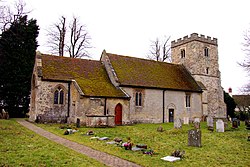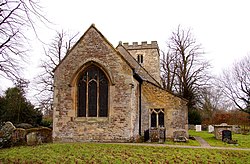Worminghall
| Worminghall | |
| Buckinghamshire | |
|---|---|
 SS Peter & Paul parish church | |
| Location | |
| Grid reference: | SP645085 |
| Location: | 51°46’19"N, 1°4’19"W |
| Data | |
| Population: | 534 (2011[1]) |
| Post town: | Aylesbury |
| Postcode: | HP18 |
| Dialling code: | 01844 |
| Local Government | |
| Council: | Buckinghamshire |
| Parliamentary constituency: |
Aylesbury |
| Website: | Worminghall Parish Council |
Worminghall is a village and parish in Buckinghamshire, adjacent to the border with Oxfordshire.
The village is beside a brook that forms most of the eastern boundary of the parish. The brook joins the River Thame, which forms the southernmost part of the eastern boundary. The western boundary of the parish also forms part of the county border with Oxfordshire. The village is about 4½ miles west of the Oxfordshire market town of Thame.
Toponym
The village toponym is derived from Old English meaning "Wyrma's nook of land". The Domesday Book of 1086 records it as Wermelle.[2] It evolved through Wormehale in the 12th and 13th centuries, Wrmehale in the 13th and 14th centuries, Worminghale in the 14th and 15th centuries and Wornall in the 18th century before reaching its current spelling.[2] "Wornall" (or "Wunnle") is still its common local pronunciation.
J. R. R. Tolkien in his novella Farmer Giles of Ham suggests (tongue-in-cheek) that the 'worm' element in Worminghall derives from the dragon in the story.
Manor
In the reign of Edward the Confessor, the manor of Worminghall was part of the estates of his queen, Edith of Wessex.[2] The Domesday Book of 1086 records that after the Norman conquest, Wermelle was assessed at five hides and was one of many manors held by the powerful Norman nobleman Geoffrey de Montbray, Bishop of Coutances.[2] Worminghall became part of the Honour of Gloucester and passed via Hugh de Audley, 1st Earl of Gloucester (1291–1347) and then Margaret de Audley, 2nd Baroness Audley to Hugh de Stafford, 2nd Earl of Stafford (died 1386).[2]
However, Thomas of Woodstock, 1st Duke of Gloucester rebelled against Richard II in 1388. Thomas was attaindered in 1397, and Worminghall was amongst the estates that Thomas forfeited to Henry of Bolingbroke, 3rd Earl of Derby.[2] When Henry's father John of Gaunt died in 1399, the Earl was crowned Henry IV and Worminghall thus became part of the Duchy of Lancaster.[2] Crown rights to Worminghall appear in a record dating from 1562.[2]
Parish church

The Church of England parish church of Saints Peter and Paul is Norman, and the north and south doorways survive from this time.[3] The chancel was built or rebuilt in the 14th century and the bell tower was added in the 15th century.[3] In 1847 the north wall was rebuilt and the present stained glass was inserted in the 15th century[2] east window.[3] The church is a Grade-II* listed building.[4]
The tower has a ring of three bells and there is also a Sanctus bell.[2] John Taylor & Co recast all four bells in 1847 at the foundry they had at the time in Oxford.[2]
Saints Peter and Paul's is now part of the Benefice of Worminghall with Ickford, Oakley and Shabbington.[5]
Social and economic history
Worminghall had a windmill by about 1160 or 1170.[6] A windmill is recorded again in the 14th century, along with a fishery.[2]
The Clifden Arms public house is a timber-framed building with brick nogging and a thatched roof.[7] The older part is medieval and the newer wing was added in the 17th century.[7] The pub's current name is more recent, being derived from an 18th or 19th century Viscount Clifden who was heir to the advowson of the parish.[2]
Wood Farm, nearly two miles west of the village, has a barn that was built in the 17th century or possibly earlier.[8] It is of six bays and is built of rubblestone with ashlar quoins, and was re-roofed in 1779 with a double purlin roof.[8]
John King founded an almshouse charity in 1670 in memory of his father Henry King (1592–1669) who was Bishop of Chichester and a poet.[2] There are ten almshouses, for six old men and four old women.[2] They were built in 1675[3][9] and are now a Grade II* listed building.[9]
A village school was built in Worminghall in the 19th century. It is now the village hall.
-
the Grade II* listed almshouses
-
Worminghall Village Hall is a Victorian building of polychromatic brick that used to be the village school.
-
The original part of the Clifden Arms (right) is medieval; the extension (left) was added in the 17th century.
-
Part of Wornal Industrial Park on the former RAF Oakley.
RAF Oakley
RAF Oakley occupied much of the northern part of Worminghall parish from 1942 until 1945. Many of its buildings survive, and those on the south side of the airfield now form the nucleus of a trading estate. This is called Wornal Industrial Park, maintaining the traditional pronunciation and 18th century spelling of the toponym.
Amenities
The Clifden Arms is now a gastropub and hotel.[10]
References
- ↑ "Key Figures for 2011 Census: Key Statistics". Neighbourhood Statistics: Full Dataset View. Office for National Statistics. http://www.neighbourhood.statistics.gov.uk/dissemination/LeadKeyFigures.do?a=7&b=11130966&c=Worminghall&d=16&e=62&g=6403917&i=1001x1003x1032x1004&m=0&r=1&s=1359923767495&enc=1. Retrieved 3 February 2013.
- ↑ 2.00 2.01 2.02 2.03 2.04 2.05 2.06 2.07 2.08 2.09 2.10 2.11 2.12 2.13 2.14 Page 1927, pp. 125–130.
- ↑ 3.0 3.1 3.2 3.3 Pevsner 1960, p. 301.
- ↑ National Heritage List 1158914: Church of St Peter and Paul
- ↑ Archbishops' Council (2010). "Benefice of Worminghall with Ickford Oakley and Shabbington". A Church Near You. The Church of England. http://www.achurchnearyou.com/_new_cofe/benefice.php?B=27/587BH. Retrieved 24 January 2012.
- ↑ Reed 1979, p. 135.
- ↑ 7.0 7.1 National Heritage List 1311280: Clifden Arms
- ↑ 8.0 8.1 National Heritage List 1124215: Barn Circa 20 Metres of Wood Farmhouse
- ↑ 9.0 9.1 National Heritage List 1124253: Almshouses
- ↑ The Clifden Arms
Sources
| ("Wikimedia Commons" has material about Worminghall) |
- Page, W.H., ed (1927). A History of the County of Buckingham, Volume 4. Victoria County History. pp. 125–130. http://www.british-history.ac.uk/report.aspx?compid=62549.
- Pevsner, Nikolaus (1960). Buckinghamshire. The Buildings of England. Harmondsworth: Penguin Books. p. 301. ISBN 0-14-071019-1.
- Reed, Michael (1979). Hoskins, W.G.; Millward, Roy. eds. The Buckinghamshire Landscape. The Making of the English Landscape. London: Hodder & Stoughton. pp. 135, 194. ISBN 0-340-19044-2.




